What Does It Take to Build an Art Deco Lamp Art Deco Statues
The difference betwixt Art Deco and Art Nouveau is often confusing. Whereas most people are vaguely familiar with the historical and stylistic developments of Fine art Nouveau and Art Deco in paintings and sculptures, 'blueprint movements' in general receive much less attending. In this article we draw the development and the principal differences between Art Deco and Fine art Nouveau.
The main difference betwixt Fine art deco en Art Nouveau
To answer the question in the title of this commodity directly: as a rule of thumb, Art Nouveau is the more than organic style whilst Art Deco tends to be more than polished. Even so, they were established in different époques with different motives. See also the examples below.
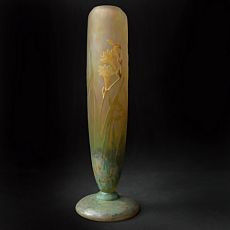 Art Nouveau vase, by Daum Frères, circa 1900
Art Nouveau vase, by Daum Frères, circa 1900
Emergence of 'applied arts'
For many centuries, fine art academies dominated the general concept of fine art all over Western Europe. Hierarchically speaking, painting and sculpture were therefore regarded as the "highest" forms of art, whereas design and the decorative arts were seen as "lower" forms, causing a widespread gap between the fine and practical arts.
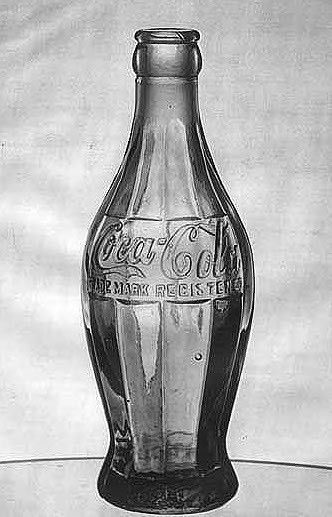 The "Coca-Cola canteen" a nice example of the 'applied' Fine art Deco style, combining beauty and functionality in an everyday design
The "Coca-Cola canteen" a nice example of the 'applied' Fine art Deco style, combining beauty and functionality in an everyday design
Towards the end of the nineteenth century, later on yet another neo-classical uprising, the desire to carelessness these strict historical styles and hierarchies grew larger. At the same time, the industrial revolution had caused production to go highly mechanized. This, in turn, made artists seek out a revival of expert adroitness.
Characteristics of Fine art Nouveau
Art Nouveau became the label that was given to the modernist motility that erupted from this desire. Information technology's hard to pinpoint the exact moment or location of its establishment, because there were several like movements taking place all over Europe at the time. But betwixt 1890 and 1914, Art Nouveau prevailed.
The Parisian art gallery La Maison de l'Art Nouveau, which was owned by the avant-garde fine art collector Siegfried Bing (1838-1905), was one of the first galleries to brandish and publicize most a large collection of works that were created during this movement. Hence why its name is ofttimes credited to this source.
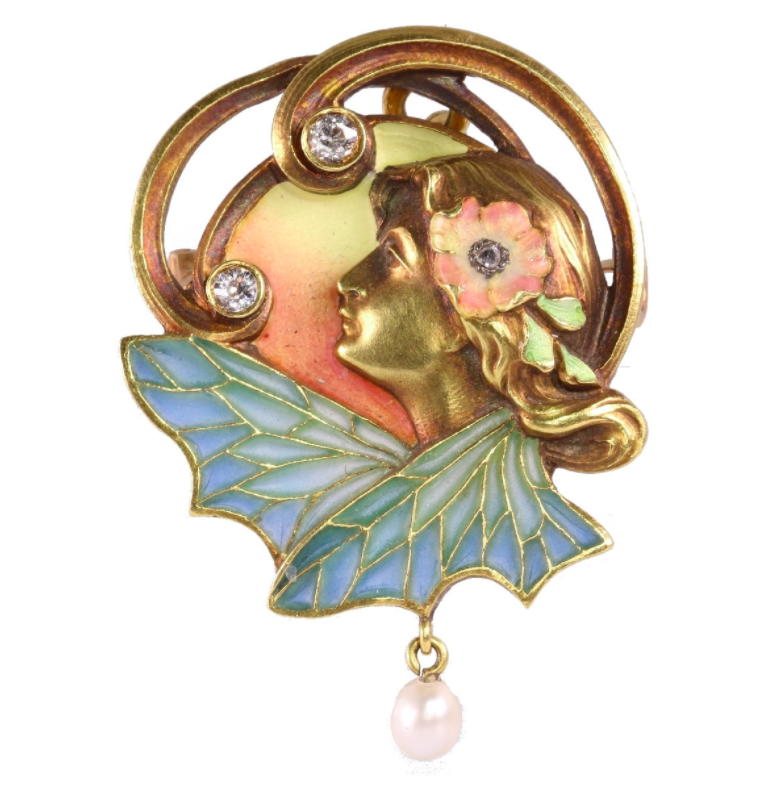 Art Nouveau pendant/ brooch 1890, available at Adin Fine Antique Jewellery
Art Nouveau pendant/ brooch 1890, available at Adin Fine Antique Jewellery
Art Nouveau artists drew their inspiration from organic and geometric forms, creating elegant and flowing designs with a distinct emphasis on contours, filled in with muted tones. The hype surrounding Japanese prints at that time, especially its floral and curved patterns, formed another very important influence.
Art Nouveau designs were applied to a wide range of disciplines, from graphic arts to furniture, interior decoration, architecture and the fine arts, exemplified at its best by Gustav Klimt'southward work.
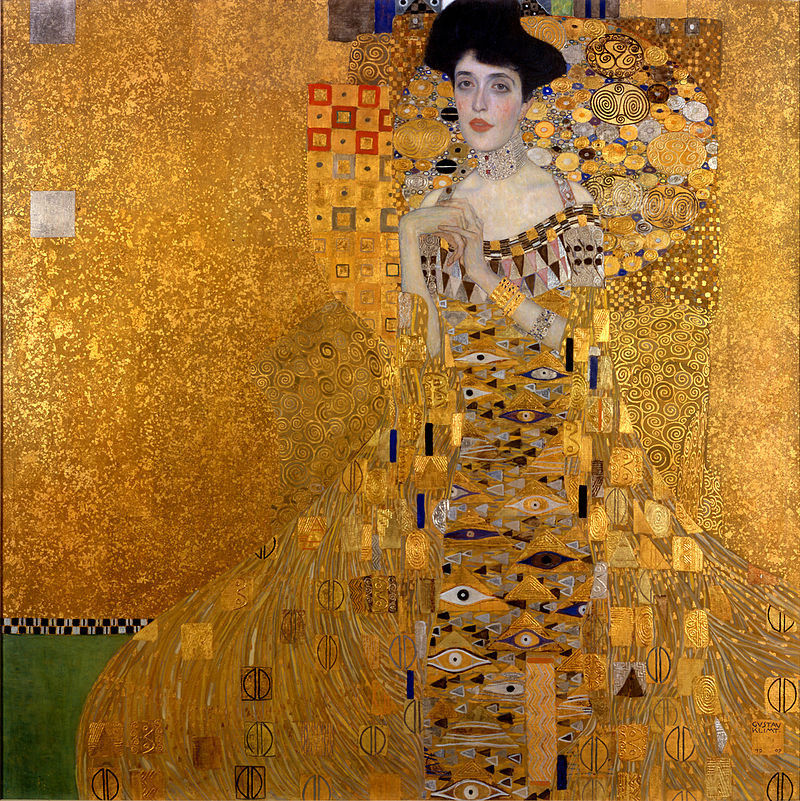 Portrait of Adele Bloch-Bauer I,also calledThe Lady in Gilt orThe Woman in Gold by Gustav Klimmt, 1907
Portrait of Adele Bloch-Bauer I,also calledThe Lady in Gilt orThe Woman in Gold by Gustav Klimmt, 1907
Effect of the Paris Exposition Universelle of 1900 on Art Nouveau
The Paris Exposition Universelle of 1900 gave Art Nouveau a major heave. It was held to celebrate the achievements of the past century and to accelerate development into the adjacent and displayed many technological innovations and the latest artworks. The fair visited by well-nigh 50 millions people was a real tape!
Different names for Art Nouveau
In Germany, the style was popularised and promoted past a magazine called Jugend illustrierte Wochenschrift für Kunst und Leben, which is the reason why in Frg (and most Nordic countries) this style is also known as "Jugendstil".
In Austria, Art Nouveau was first popularised by artists of the Viennese Secession movement, which led to the proper noun Sezessionstil.
Even in English speaking countries, different terms were used to describe this decorative fashion; in the United States it was referred to as the 'Tiffany Style' and in the United Kingdom people also spoke of the Glasgow Fashion.
Despite the big variety across different countries and areas of design, the mutual denominator of Art Nouveau was a determination to push beyond the historical boundaries.
Particular of the 'Art Nouveau style" façade of the Hotel Céramic, Paris
Fine art Nouveau artists wanted to create a new reality, a modern world with its own vocabulary. The style is characterised by the raw forcefulness of nature, showing dynamic, whiplash curves and motifs. Present, Art Nouveau is considered to take paved the way for the mod art and design styles of the 20th century. A dandy number of its monuments are also listed as UNESCO World Heritage, including the historic middle of Riga and Hotel Tassel in Belgium.
Emergence of Art Deco
Just before the Beginning World War, Art Nouveau had already started to fade out, making way for a more modernistic aesthetic: Art Deco.
Decorative artists experienced a ascent in condition post-obit the plow of the century; similarly, a rise in wealth and social besides equally technological progress gave nascency to the widespread luxury industry. This gold combination solidified the Art Deco move.
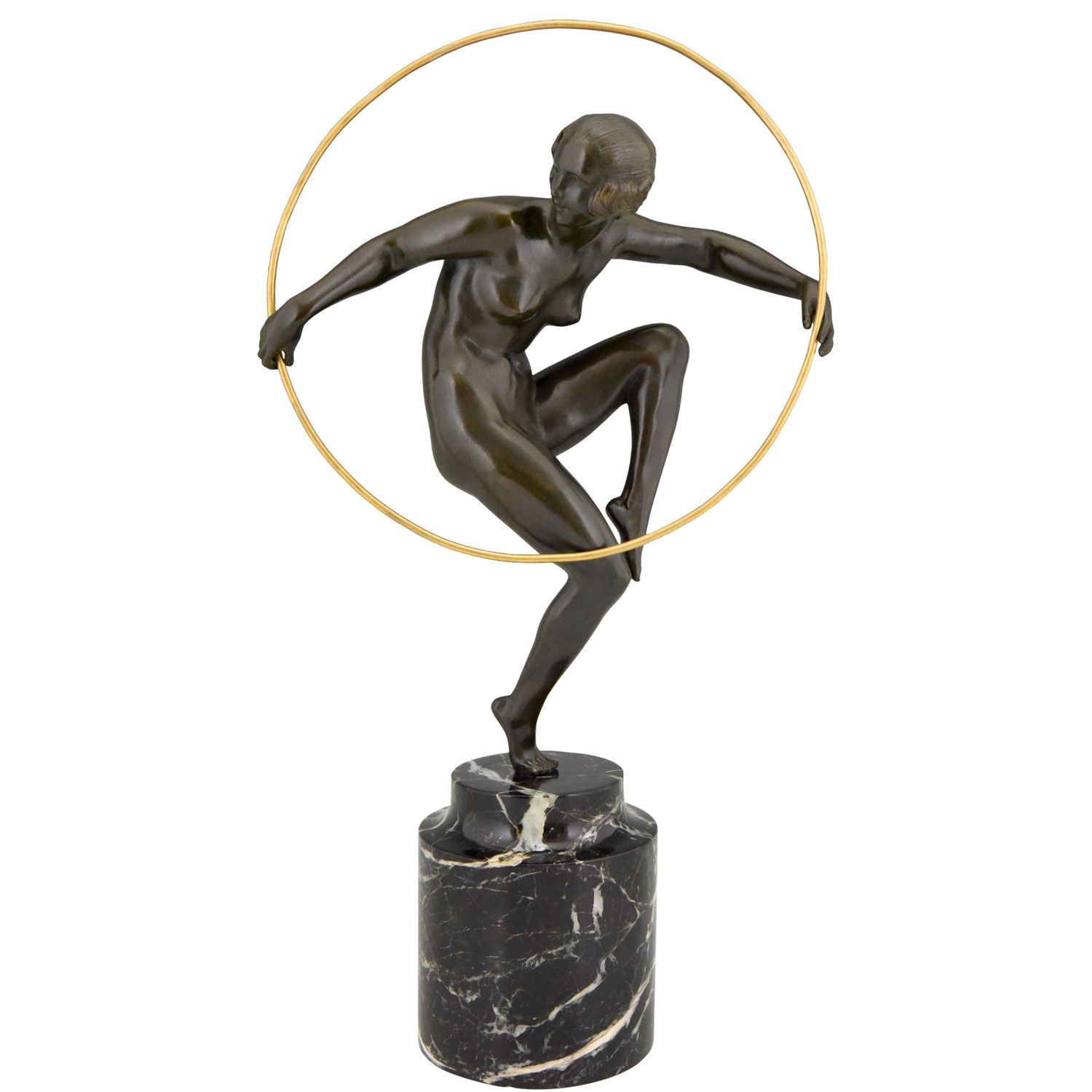 Art Deco sculpure 'Nude Hoop Dancer' by Andre Marcel Bouraine (Briand), c.a. 1925, past gallery 'Het Ware Huis'
Art Deco sculpure 'Nude Hoop Dancer' by Andre Marcel Bouraine (Briand), c.a. 1925, past gallery 'Het Ware Huis'
Fine art Deco truly embraced the influence of the industrial revolution. Art Deco designs were therefore more symmetrical and streamlined, attempting to make machine-made objects more aesthetically appealing to everybody.
The Chrysler Building designed by William of Alen'south for instance can be seen equally an real Art Deco icon. The utilise of curved forms and assuming colours are very typical.
Typical example of Art Deco, 1930, The Chrysler Building, New York
Art Deco was adopted by designers and architects around the globe and has left behind an impressive legacy in a keen number of cities. Art Deco was besides highly influenced by the contemporary artists of that menses, especially by the abstract shapes and forms of the Cubists, notably Pablo Picasso and Georges Braque.
As well glass every bit an medium enjoyed an important status throughout the Art Deco era, it became a staple of the luxury manufacture. René Lalique'due south piece of work is peculiarly symbolic of this period.
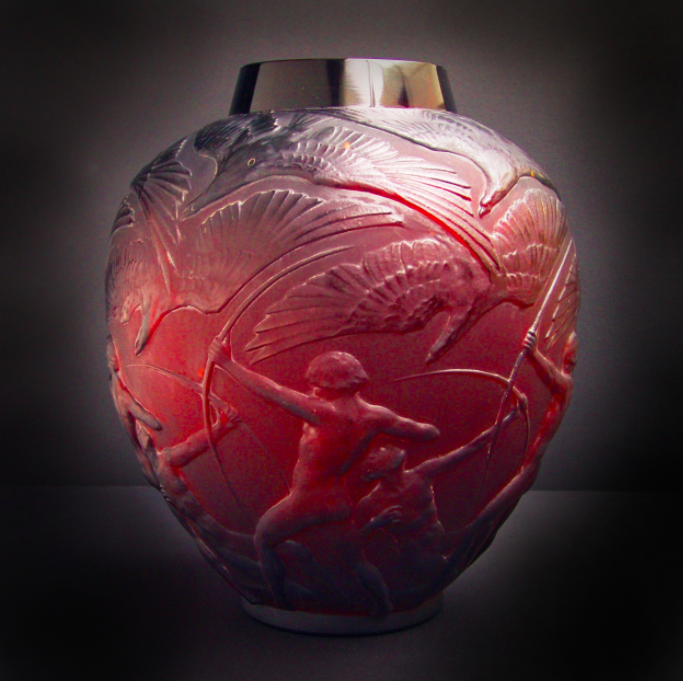 René Lalique, Art Deco manner vase 'Archers', 1921 available through Lennart Booij Fine Art and Rare Items
René Lalique, Art Deco manner vase 'Archers', 1921 available through Lennart Booij Fine Art and Rare Items
Contrary to Art Nouveau, the definition of the Art Deco motility derived from a unmarried source: the Exposition Internationales des Arts Décoratifs et Industriels Modernesthat took place in 1925. In France, Art Deco was referred to as Style Moderne.Art Deco remained the decorative art style during the 20's and 30'southward and was in a sense more than eclectic, equally it encompassed elements from different styles.
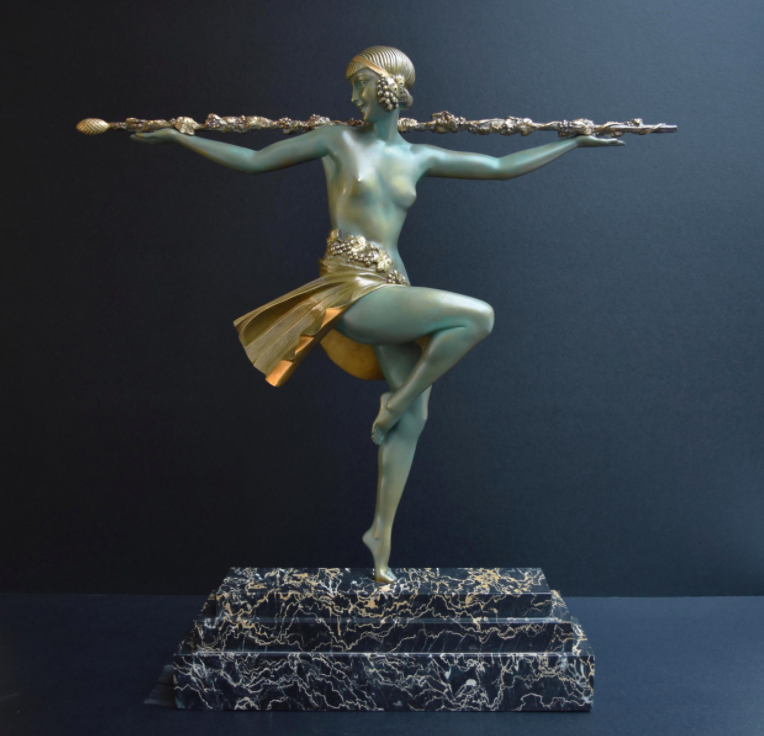 Art Deco sculpture 'Dancer with Thyrsus' by Pierre le Faguays, 1925
Art Deco sculpture 'Dancer with Thyrsus' by Pierre le Faguays, 1925
Modern art replaces Art Deco
Unfortunately, Europe was hitting past the Great Depression during the 1930's. The average wealth plummeted, leaving many Fine art Deco enthousiasts to no longer exist able to afford its rich materials, luxury items and piece of furniture. In terms of architecture, Art Deco also had a difficult time competing with modern architecture, equally epitomised by the work of Le Corbusier and the High german Bauhaus movement.
Le Corbusier was a bright spokesperson for modern architecture, he considered a house to be no more than "a car to live in". He also famously declared the decorative arts to be a dying medium.
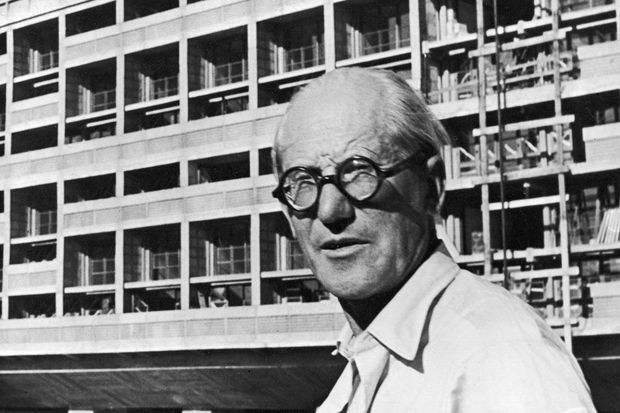 Photograph of Le Corbusier, one of the founders of modernistic art
Photograph of Le Corbusier, one of the founders of modernistic art
Le Corbusier's ideas were somewhen adopted by architecture schools and the aesthetics of Art Deco were slowly abandoned. After Globe War II the style had gone completely out of fashion, with certain areas of industrial pattern remaining equally the only exception.
Summary main divergence Art Deco and Art Nouveau
Hopefully the departure betwixt Fine art Nouveau and Art Deco has now get articulate to yous. Aside from the aspect of timing, what sets these two pattern movements apart largely comes down to aesthetics. The organic and flowing forms that define Art Nouveau were a articulate response to creative person's desire to break free from rigid classical and hierarchical structures, whereas the bolder and streamlined designs of Art Deco reflect the glamorization of the industrial revolution.
Where to buy Art deco and Art Nouveau?
If you would like to buy delight have a wait at a wide multifariousness of Fine art Nouveau or Art Deco artworks which are available for auction at Gallerease!
Are y'all searching for a specific Art Nouveau artist, like: Emile Gallé, Daum Frères, Clement Massier?
Or are you lot interested in more information near Fine art Deco artists? They tin can be seen hither, like: René Lalique, and Camille Fauré!
Source: https://gallerease.com/en/magazine/articles/the-difference-between-art-nouveau-and-art-deco-explained__6ae04a6d3cbf
Post a Comment for "What Does It Take to Build an Art Deco Lamp Art Deco Statues"